Understanding Cultural Safety in Nursing Practice
VerifiedAdded on 2023/01/11
|11
|2909
|35
AI Summary
This essay explores the key concepts of cultural safety in nursing practice, including personal and institutional racism, white privilege, and the importance of cultural competence. It also discusses the role of nurses in promoting cultural safety and the principles of cultural safety in nursing practice.
Contribute Materials
Your contribution can guide someone’s learning journey. Share your
documents today.

Running head: CULTURAL SAFETY ESSAY
CULTURAL SAFETY ESSAY
Name of the Student:
Name of the University:
Author Note:
CULTURAL SAFETY ESSAY
Name of the Student:
Name of the University:
Author Note:
Secure Best Marks with AI Grader
Need help grading? Try our AI Grader for instant feedback on your assignments.
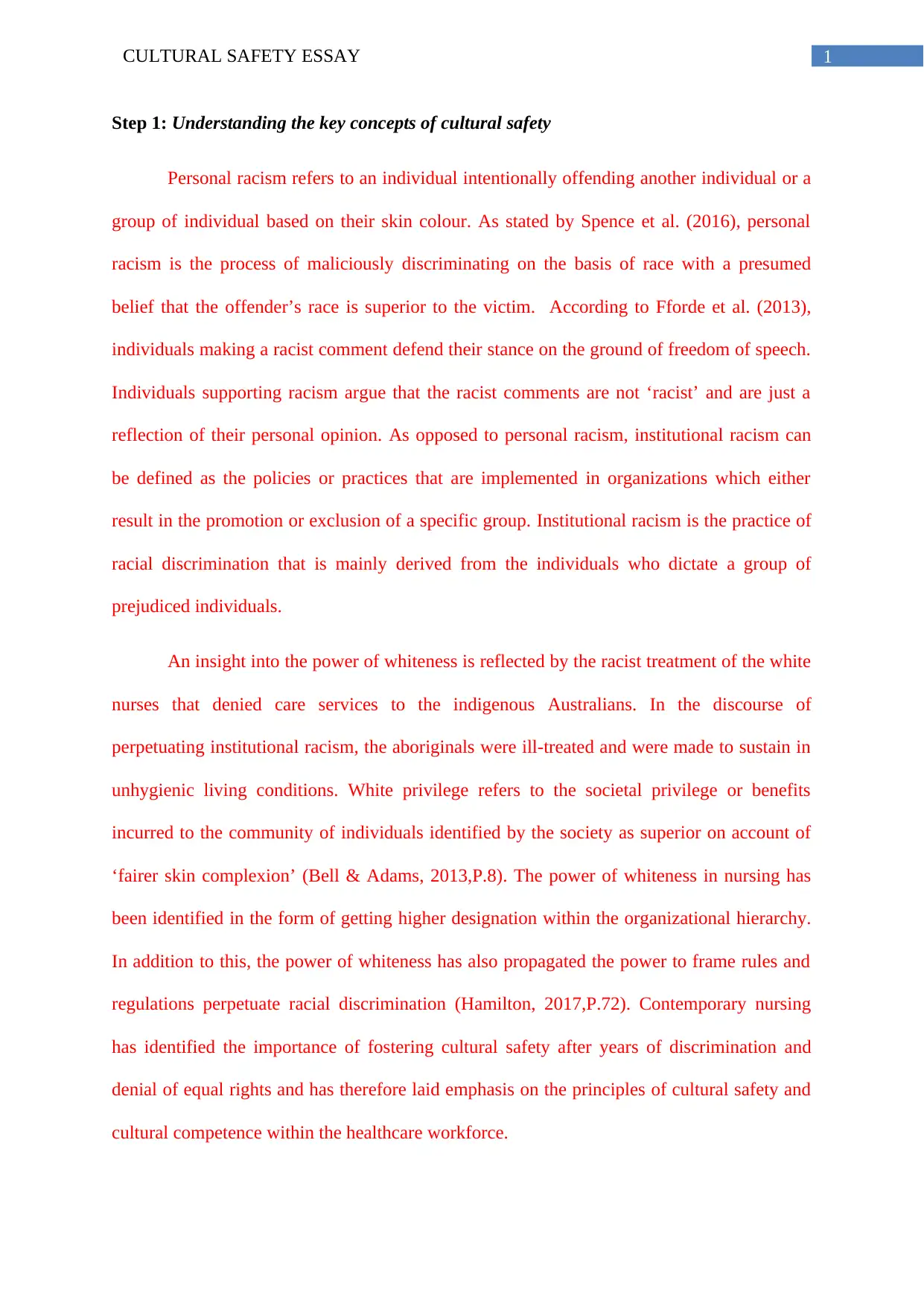
1CULTURAL SAFETY ESSAY
Step 1: Understanding the key concepts of cultural safety
Personal racism refers to an individual intentionally offending another individual or a
group of individual based on their skin colour. As stated by Spence et al. (2016), personal
racism is the process of maliciously discriminating on the basis of race with a presumed
belief that the offender’s race is superior to the victim. According to Fforde et al. (2013),
individuals making a racist comment defend their stance on the ground of freedom of speech.
Individuals supporting racism argue that the racist comments are not ‘racist’ and are just a
reflection of their personal opinion. As opposed to personal racism, institutional racism can
be defined as the policies or practices that are implemented in organizations which either
result in the promotion or exclusion of a specific group. Institutional racism is the practice of
racial discrimination that is mainly derived from the individuals who dictate a group of
prejudiced individuals.
An insight into the power of whiteness is reflected by the racist treatment of the white
nurses that denied care services to the indigenous Australians. In the discourse of
perpetuating institutional racism, the aboriginals were ill-treated and were made to sustain in
unhygienic living conditions. White privilege refers to the societal privilege or benefits
incurred to the community of individuals identified by the society as superior on account of
‘fairer skin complexion’ (Bell & Adams, 2013,P.8). The power of whiteness in nursing has
been identified in the form of getting higher designation within the organizational hierarchy.
In addition to this, the power of whiteness has also propagated the power to frame rules and
regulations perpetuate racial discrimination (Hamilton, 2017,P.72). Contemporary nursing
has identified the importance of fostering cultural safety after years of discrimination and
denial of equal rights and has therefore laid emphasis on the principles of cultural safety and
cultural competence within the healthcare workforce.
Step 1: Understanding the key concepts of cultural safety
Personal racism refers to an individual intentionally offending another individual or a
group of individual based on their skin colour. As stated by Spence et al. (2016), personal
racism is the process of maliciously discriminating on the basis of race with a presumed
belief that the offender’s race is superior to the victim. According to Fforde et al. (2013),
individuals making a racist comment defend their stance on the ground of freedom of speech.
Individuals supporting racism argue that the racist comments are not ‘racist’ and are just a
reflection of their personal opinion. As opposed to personal racism, institutional racism can
be defined as the policies or practices that are implemented in organizations which either
result in the promotion or exclusion of a specific group. Institutional racism is the practice of
racial discrimination that is mainly derived from the individuals who dictate a group of
prejudiced individuals.
An insight into the power of whiteness is reflected by the racist treatment of the white
nurses that denied care services to the indigenous Australians. In the discourse of
perpetuating institutional racism, the aboriginals were ill-treated and were made to sustain in
unhygienic living conditions. White privilege refers to the societal privilege or benefits
incurred to the community of individuals identified by the society as superior on account of
‘fairer skin complexion’ (Bell & Adams, 2013,P.8). The power of whiteness in nursing has
been identified in the form of getting higher designation within the organizational hierarchy.
In addition to this, the power of whiteness has also propagated the power to frame rules and
regulations perpetuate racial discrimination (Hamilton, 2017,P.72). Contemporary nursing
has identified the importance of fostering cultural safety after years of discrimination and
denial of equal rights and has therefore laid emphasis on the principles of cultural safety and
cultural competence within the healthcare workforce.
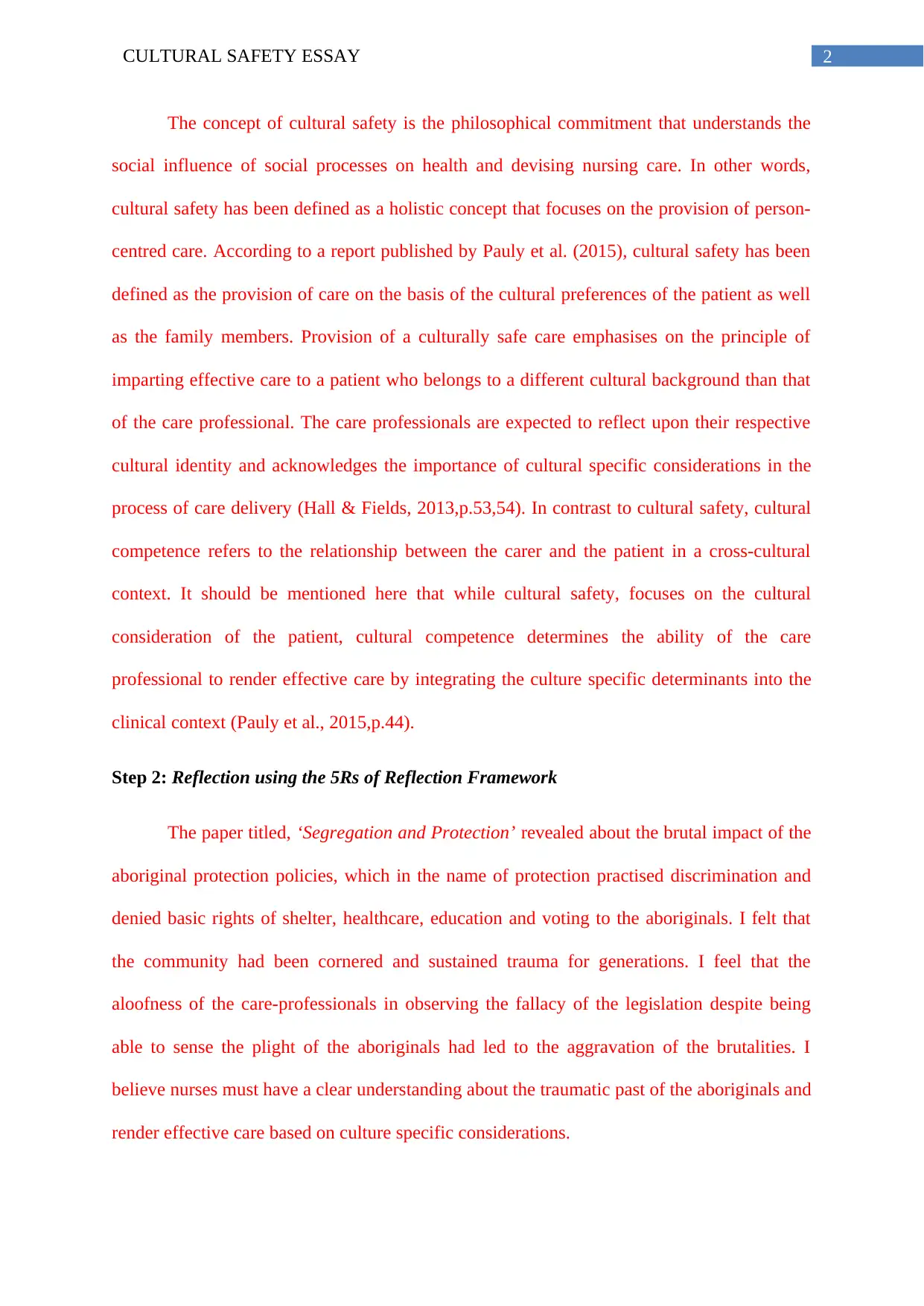
2CULTURAL SAFETY ESSAY
The concept of cultural safety is the philosophical commitment that understands the
social influence of social processes on health and devising nursing care. In other words,
cultural safety has been defined as a holistic concept that focuses on the provision of person-
centred care. According to a report published by Pauly et al. (2015), cultural safety has been
defined as the provision of care on the basis of the cultural preferences of the patient as well
as the family members. Provision of a culturally safe care emphasises on the principle of
imparting effective care to a patient who belongs to a different cultural background than that
of the care professional. The care professionals are expected to reflect upon their respective
cultural identity and acknowledges the importance of cultural specific considerations in the
process of care delivery (Hall & Fields, 2013,p.53,54). In contrast to cultural safety, cultural
competence refers to the relationship between the carer and the patient in a cross-cultural
context. It should be mentioned here that while cultural safety, focuses on the cultural
consideration of the patient, cultural competence determines the ability of the care
professional to render effective care by integrating the culture specific determinants into the
clinical context (Pauly et al., 2015,p.44).
Step 2: Reflection using the 5Rs of Reflection Framework
The paper titled, ‘Segregation and Protection’ revealed about the brutal impact of the
aboriginal protection policies, which in the name of protection practised discrimination and
denied basic rights of shelter, healthcare, education and voting to the aboriginals. I felt that
the community had been cornered and sustained trauma for generations. I feel that the
aloofness of the care-professionals in observing the fallacy of the legislation despite being
able to sense the plight of the aboriginals had led to the aggravation of the brutalities. I
believe nurses must have a clear understanding about the traumatic past of the aboriginals and
render effective care based on culture specific considerations.
The concept of cultural safety is the philosophical commitment that understands the
social influence of social processes on health and devising nursing care. In other words,
cultural safety has been defined as a holistic concept that focuses on the provision of person-
centred care. According to a report published by Pauly et al. (2015), cultural safety has been
defined as the provision of care on the basis of the cultural preferences of the patient as well
as the family members. Provision of a culturally safe care emphasises on the principle of
imparting effective care to a patient who belongs to a different cultural background than that
of the care professional. The care professionals are expected to reflect upon their respective
cultural identity and acknowledges the importance of cultural specific considerations in the
process of care delivery (Hall & Fields, 2013,p.53,54). In contrast to cultural safety, cultural
competence refers to the relationship between the carer and the patient in a cross-cultural
context. It should be mentioned here that while cultural safety, focuses on the cultural
consideration of the patient, cultural competence determines the ability of the care
professional to render effective care by integrating the culture specific determinants into the
clinical context (Pauly et al., 2015,p.44).
Step 2: Reflection using the 5Rs of Reflection Framework
The paper titled, ‘Segregation and Protection’ revealed about the brutal impact of the
aboriginal protection policies, which in the name of protection practised discrimination and
denied basic rights of shelter, healthcare, education and voting to the aboriginals. I felt that
the community had been cornered and sustained trauma for generations. I feel that the
aloofness of the care-professionals in observing the fallacy of the legislation despite being
able to sense the plight of the aboriginals had led to the aggravation of the brutalities. I
believe nurses must have a clear understanding about the traumatic past of the aboriginals and
render effective care based on culture specific considerations.
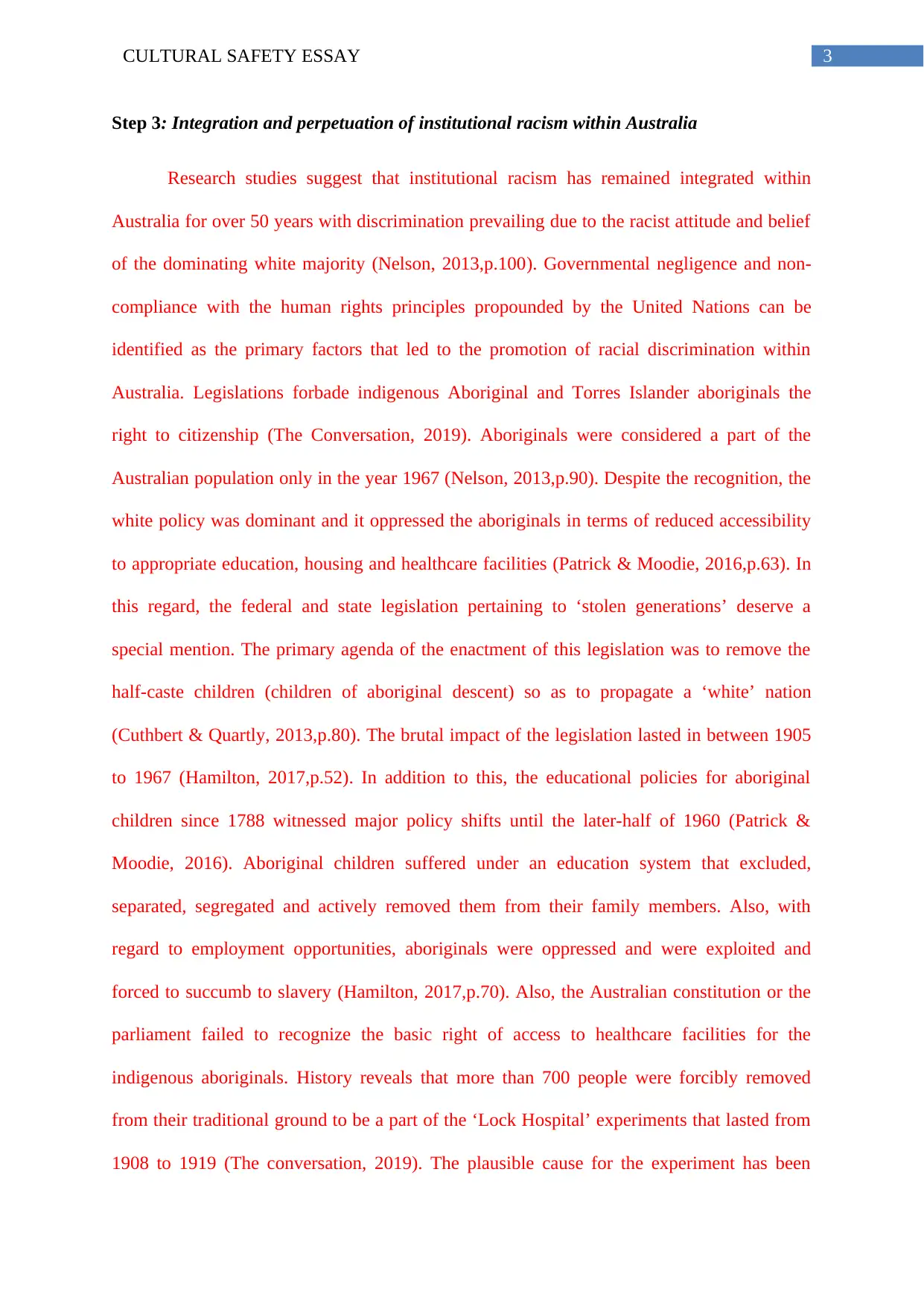
3CULTURAL SAFETY ESSAY
Step 3: Integration and perpetuation of institutional racism within Australia
Research studies suggest that institutional racism has remained integrated within
Australia for over 50 years with discrimination prevailing due to the racist attitude and belief
of the dominating white majority (Nelson, 2013,p.100). Governmental negligence and non-
compliance with the human rights principles propounded by the United Nations can be
identified as the primary factors that led to the promotion of racial discrimination within
Australia. Legislations forbade indigenous Aboriginal and Torres Islander aboriginals the
right to citizenship (The Conversation, 2019). Aboriginals were considered a part of the
Australian population only in the year 1967 (Nelson, 2013,p.90). Despite the recognition, the
white policy was dominant and it oppressed the aboriginals in terms of reduced accessibility
to appropriate education, housing and healthcare facilities (Patrick & Moodie, 2016,p.63). In
this regard, the federal and state legislation pertaining to ‘stolen generations’ deserve a
special mention. The primary agenda of the enactment of this legislation was to remove the
half-caste children (children of aboriginal descent) so as to propagate a ‘white’ nation
(Cuthbert & Quartly, 2013,p.80). The brutal impact of the legislation lasted in between 1905
to 1967 (Hamilton, 2017,p.52). In addition to this, the educational policies for aboriginal
children since 1788 witnessed major policy shifts until the later-half of 1960 (Patrick &
Moodie, 2016). Aboriginal children suffered under an education system that excluded,
separated, segregated and actively removed them from their family members. Also, with
regard to employment opportunities, aboriginals were oppressed and were exploited and
forced to succumb to slavery (Hamilton, 2017,p.70). Also, the Australian constitution or the
parliament failed to recognize the basic right of access to healthcare facilities for the
indigenous aboriginals. History reveals that more than 700 people were forcibly removed
from their traditional ground to be a part of the ‘Lock Hospital’ experiments that lasted from
1908 to 1919 (The conversation, 2019). The plausible cause for the experiment has been
Step 3: Integration and perpetuation of institutional racism within Australia
Research studies suggest that institutional racism has remained integrated within
Australia for over 50 years with discrimination prevailing due to the racist attitude and belief
of the dominating white majority (Nelson, 2013,p.100). Governmental negligence and non-
compliance with the human rights principles propounded by the United Nations can be
identified as the primary factors that led to the promotion of racial discrimination within
Australia. Legislations forbade indigenous Aboriginal and Torres Islander aboriginals the
right to citizenship (The Conversation, 2019). Aboriginals were considered a part of the
Australian population only in the year 1967 (Nelson, 2013,p.90). Despite the recognition, the
white policy was dominant and it oppressed the aboriginals in terms of reduced accessibility
to appropriate education, housing and healthcare facilities (Patrick & Moodie, 2016,p.63). In
this regard, the federal and state legislation pertaining to ‘stolen generations’ deserve a
special mention. The primary agenda of the enactment of this legislation was to remove the
half-caste children (children of aboriginal descent) so as to propagate a ‘white’ nation
(Cuthbert & Quartly, 2013,p.80). The brutal impact of the legislation lasted in between 1905
to 1967 (Hamilton, 2017,p.52). In addition to this, the educational policies for aboriginal
children since 1788 witnessed major policy shifts until the later-half of 1960 (Patrick &
Moodie, 2016). Aboriginal children suffered under an education system that excluded,
separated, segregated and actively removed them from their family members. Also, with
regard to employment opportunities, aboriginals were oppressed and were exploited and
forced to succumb to slavery (Hamilton, 2017,p.70). Also, the Australian constitution or the
parliament failed to recognize the basic right of access to healthcare facilities for the
indigenous aboriginals. History reveals that more than 700 people were forcibly removed
from their traditional ground to be a part of the ‘Lock Hospital’ experiments that lasted from
1908 to 1919 (The conversation, 2019). The plausible cause for the experiment has been
Secure Best Marks with AI Grader
Need help grading? Try our AI Grader for instant feedback on your assignments.

4CULTURAL SAFETY ESSAY
mentioned as ‘veneral disease’ without a confirmed diagnosis (The conversation, 2019). The
interventions offered at the lock hospital included, traumas of colonization, neck chaining for
hours, brutal torture and a high mortality rate (Reading & Greenwood, 2015,p.24).
The Racial Discrimination Act was passed in the year 1975, which marked the
acknowledgement of aboriginals as Australian citizens (Hall & Fields, 2013,p.8). However,
institutional discrimination still exists in Australia which is marked by the high percentage of
Aboriginal and Torres Strait Islander workers experiencing discrimination at work,
educational institutions and at healthcare facilities.
Step 4: Principles of cultural safety in nursing practice
According to the nursing Competency 1.5, published by the Nursing Council of New
Zealand, it is expected that nurses must render culturally safe care to the patient. The primary
focus of culturally safe nursing care is to establish a therapeutic relationship between the care
provider and the patient as well as the family members (Cox & Tauna, 2019,p.45). It should
be noted in this context, that the NMBA document also states that upon entering into
profession a graduate nurse must ensure cultural safety within the scope of practice and act in
the way that preserves the dignity and integrity of the patient (Health.gov.au, 2019). On a
broader note, nurses are expected to identify the culture specific needs of the patient and
provide culturally safe care that ensures holistic wellbeing of the patient within the cultural
community.
According to the Joint Statement published by the Nursing and Midwifery Board of
Australia, care professionals are expected to promote a culturally safe care environment
(Acn.edu.au, 2019). The principle of cultural safety includes the elements of respect, support,
empowerment, identity, protection of human rights and establishing a healthy therapeutic
partnership with the aboriginal and Torres Islander community members. The principles of
mentioned as ‘veneral disease’ without a confirmed diagnosis (The conversation, 2019). The
interventions offered at the lock hospital included, traumas of colonization, neck chaining for
hours, brutal torture and a high mortality rate (Reading & Greenwood, 2015,p.24).
The Racial Discrimination Act was passed in the year 1975, which marked the
acknowledgement of aboriginals as Australian citizens (Hall & Fields, 2013,p.8). However,
institutional discrimination still exists in Australia which is marked by the high percentage of
Aboriginal and Torres Strait Islander workers experiencing discrimination at work,
educational institutions and at healthcare facilities.
Step 4: Principles of cultural safety in nursing practice
According to the nursing Competency 1.5, published by the Nursing Council of New
Zealand, it is expected that nurses must render culturally safe care to the patient. The primary
focus of culturally safe nursing care is to establish a therapeutic relationship between the care
provider and the patient as well as the family members (Cox & Tauna, 2019,p.45). It should
be noted in this context, that the NMBA document also states that upon entering into
profession a graduate nurse must ensure cultural safety within the scope of practice and act in
the way that preserves the dignity and integrity of the patient (Health.gov.au, 2019). On a
broader note, nurses are expected to identify the culture specific needs of the patient and
provide culturally safe care that ensures holistic wellbeing of the patient within the cultural
community.
According to the Joint Statement published by the Nursing and Midwifery Board of
Australia, care professionals are expected to promote a culturally safe care environment
(Acn.edu.au, 2019). The principle of cultural safety includes the elements of respect, support,
empowerment, identity, protection of human rights and establishing a healthy therapeutic
partnership with the aboriginal and Torres Islander community members. The principles of

5CULTURAL SAFETY ESSAY
cultural safety have been built on the plight of the aboriginals in relation to personal and
institutional discrimination and intend to protect to the cultural beliefs and practices of the
indigenous Australians. According to Acn.edu.au (2019), cultural safety principles have been
defined to bridge the power imbalances between the carer and the recipients so as to render
effective care services. This means that a nurse is expected to appreciate the cultural
differences, acknowledge the differences and reflect upon the difference to devise care in a
manner that does not elicit a detrimental effect on the recipient. Further, principles of cultural
safety also ensure transparency of communication to avoid any misunderstanding that could
potentially lead to patient harm (Pauly et al., 2015,p.18).
cultural safety have been built on the plight of the aboriginals in relation to personal and
institutional discrimination and intend to protect to the cultural beliefs and practices of the
indigenous Australians. According to Acn.edu.au (2019), cultural safety principles have been
defined to bridge the power imbalances between the carer and the recipients so as to render
effective care services. This means that a nurse is expected to appreciate the cultural
differences, acknowledge the differences and reflect upon the difference to devise care in a
manner that does not elicit a detrimental effect on the recipient. Further, principles of cultural
safety also ensure transparency of communication to avoid any misunderstanding that could
potentially lead to patient harm (Pauly et al., 2015,p.18).

6CULTURAL SAFETY ESSAY
Step 5: Role of nurses in promoting cultural safety
This assignment has helped me to appreciate the history of aboriginal and Torres
Islander community members. I have developed a clear insight about the brutal past and the
prevailing racism culture that added to the plight of the indigenous Australians. I have further
understood the importance of promoting culturally safe care to the patients belonging to the
indigenous community. I have also developed a clear understanding about the principles of
cultural safety and how cultural safety could help in acquiring positive patient outcome. It is
extremely important to pay attention to the culture specific preferences of the patient while
devising a care plan. I would further comply with the competence standards mentioned in the
NMBA document about rendering culturally safe care intervention. I would apply the
principles of cultural safety into my nursing practice. While assessing the patient I would
identify the impact of the culture of nursing on the patient care quality and try my best to
protect the patient’s wellness within the specific culture. I would practice in way that it does
not hamper the personal beliefs, values or goals of the patient. I would do this by assisting the
client to get appropriate support from carers who are able to understand the specific cultural
needs or preferences of the patient. For example, upon my clinical placement, if I am
expected to conduct an assessment of an aboriginal female or a male, I would first ask the
patient about their cultural preferences as well as gender specific preferences while
conducting the assessment. This means I would ask the aboriginal patient that if he would
like to be assessed by another care professional who belongs to the same culture. Also, if I
am supposed to conduct an abdominal assessment of an aboriginal patient belonging to the
opposite sex, I would ask the patient his gender preferences and only upon obtaining consent
I would proceed with the assessment. Further, if there is a need to involve the
multidisciplinary team to plan care for an aboriginal patient, I would consult with the
members belonging to the same culture as that of the patient. Also, while creating the care
Step 5: Role of nurses in promoting cultural safety
This assignment has helped me to appreciate the history of aboriginal and Torres
Islander community members. I have developed a clear insight about the brutal past and the
prevailing racism culture that added to the plight of the indigenous Australians. I have further
understood the importance of promoting culturally safe care to the patients belonging to the
indigenous community. I have also developed a clear understanding about the principles of
cultural safety and how cultural safety could help in acquiring positive patient outcome. It is
extremely important to pay attention to the culture specific preferences of the patient while
devising a care plan. I would further comply with the competence standards mentioned in the
NMBA document about rendering culturally safe care intervention. I would apply the
principles of cultural safety into my nursing practice. While assessing the patient I would
identify the impact of the culture of nursing on the patient care quality and try my best to
protect the patient’s wellness within the specific culture. I would practice in way that it does
not hamper the personal beliefs, values or goals of the patient. I would do this by assisting the
client to get appropriate support from carers who are able to understand the specific cultural
needs or preferences of the patient. For example, upon my clinical placement, if I am
expected to conduct an assessment of an aboriginal female or a male, I would first ask the
patient about their cultural preferences as well as gender specific preferences while
conducting the assessment. This means I would ask the aboriginal patient that if he would
like to be assessed by another care professional who belongs to the same culture. Also, if I
am supposed to conduct an abdominal assessment of an aboriginal patient belonging to the
opposite sex, I would ask the patient his gender preferences and only upon obtaining consent
I would proceed with the assessment. Further, if there is a need to involve the
multidisciplinary team to plan care for an aboriginal patient, I would consult with the
members belonging to the same culture as that of the patient. Also, while creating the care
Paraphrase This Document
Need a fresh take? Get an instant paraphrase of this document with our AI Paraphraser
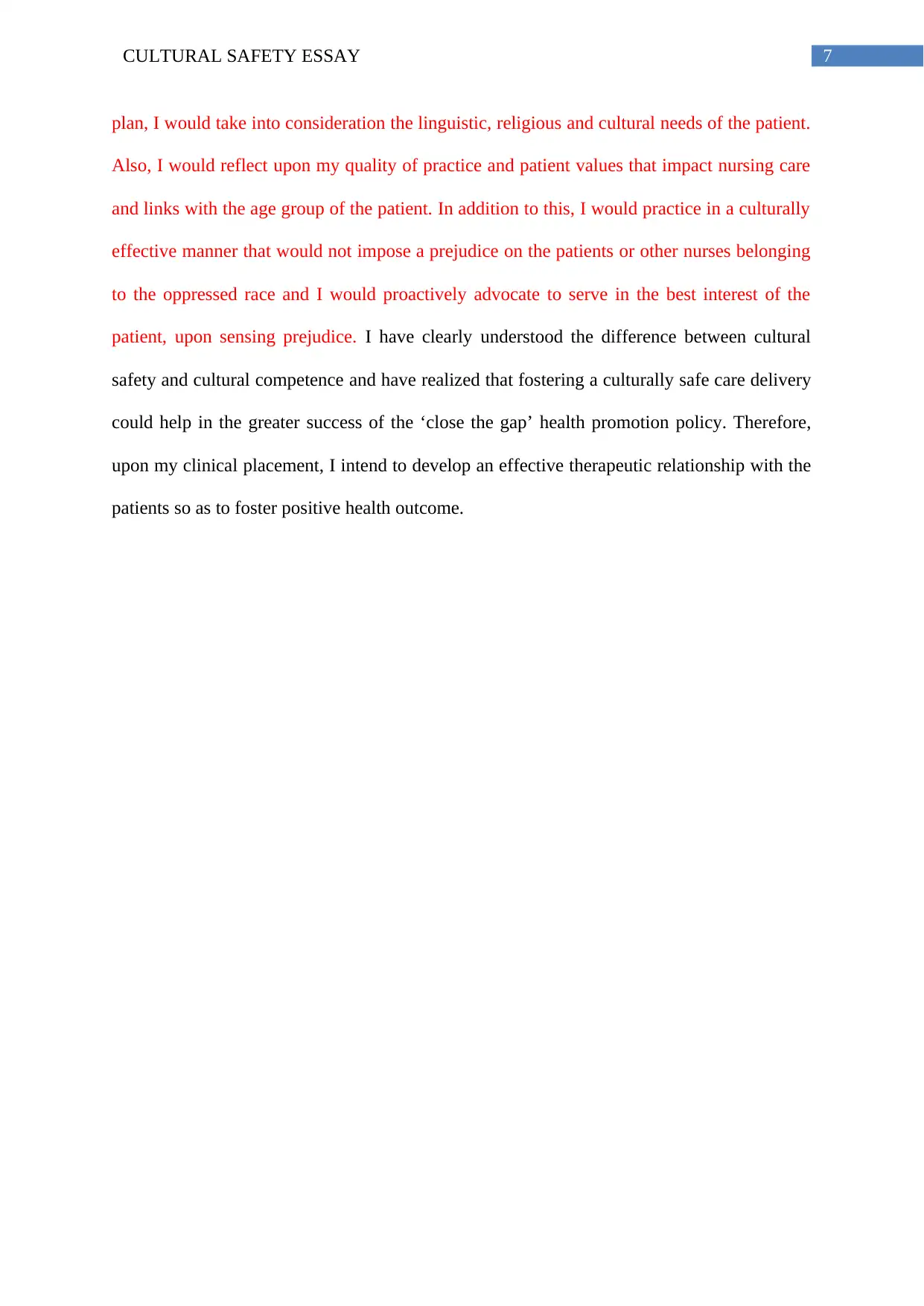
7CULTURAL SAFETY ESSAY
plan, I would take into consideration the linguistic, religious and cultural needs of the patient.
Also, I would reflect upon my quality of practice and patient values that impact nursing care
and links with the age group of the patient. In addition to this, I would practice in a culturally
effective manner that would not impose a prejudice on the patients or other nurses belonging
to the oppressed race and I would proactively advocate to serve in the best interest of the
patient, upon sensing prejudice. I have clearly understood the difference between cultural
safety and cultural competence and have realized that fostering a culturally safe care delivery
could help in the greater success of the ‘close the gap’ health promotion policy. Therefore,
upon my clinical placement, I intend to develop an effective therapeutic relationship with the
patients so as to foster positive health outcome.
plan, I would take into consideration the linguistic, religious and cultural needs of the patient.
Also, I would reflect upon my quality of practice and patient values that impact nursing care
and links with the age group of the patient. In addition to this, I would practice in a culturally
effective manner that would not impose a prejudice on the patients or other nurses belonging
to the oppressed race and I would proactively advocate to serve in the best interest of the
patient, upon sensing prejudice. I have clearly understood the difference between cultural
safety and cultural competence and have realized that fostering a culturally safe care delivery
could help in the greater success of the ‘close the gap’ health promotion policy. Therefore,
upon my clinical placement, I intend to develop an effective therapeutic relationship with the
patients so as to foster positive health outcome.
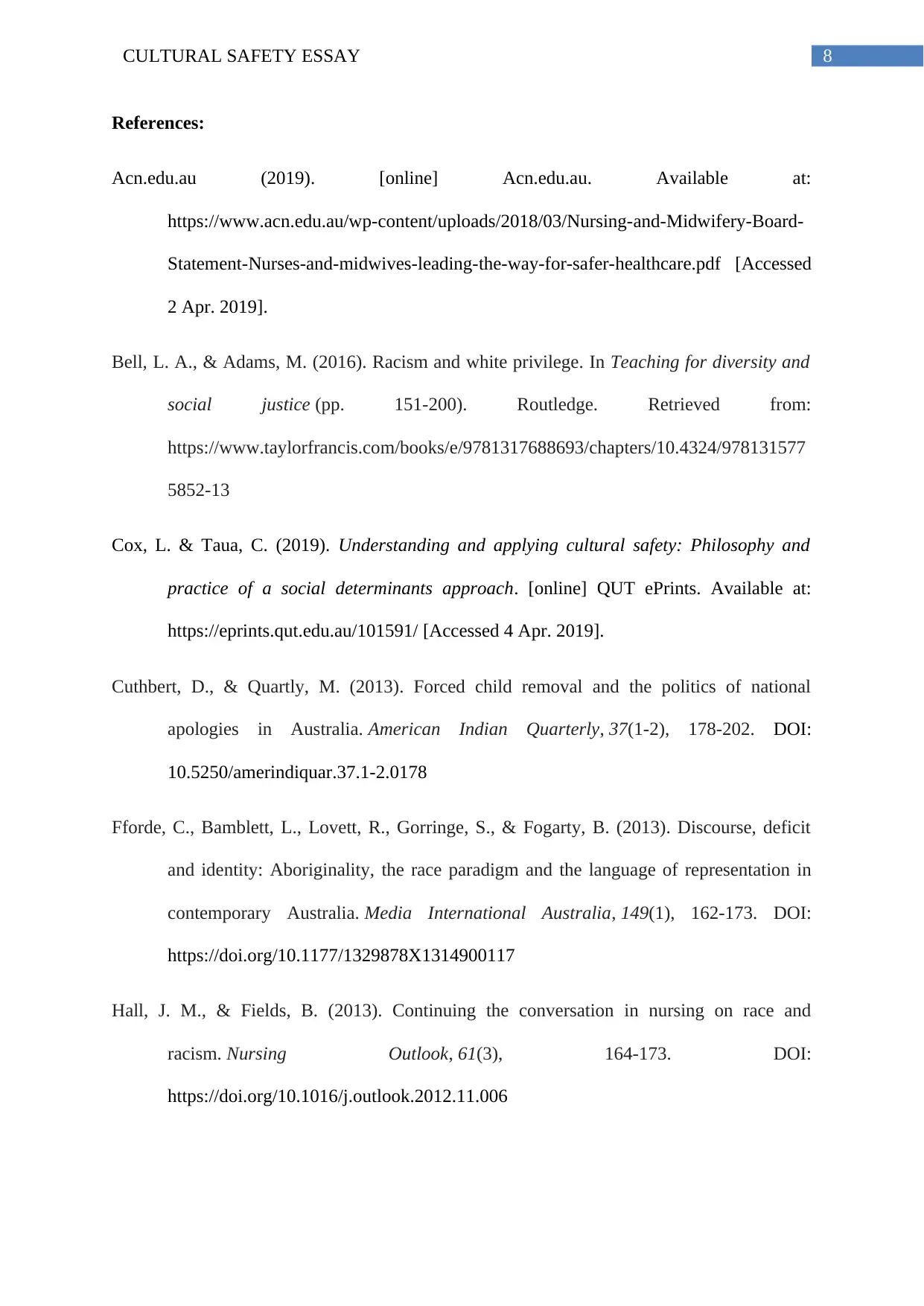
8CULTURAL SAFETY ESSAY
References:
Acn.edu.au (2019). [online] Acn.edu.au. Available at:
https://www.acn.edu.au/wp-content/uploads/2018/03/Nursing-and-Midwifery-Board-
Statement-Nurses-and-midwives-leading-the-way-for-safer-healthcare.pdf [Accessed
2 Apr. 2019].
Bell, L. A., & Adams, M. (2016). Racism and white privilege. In Teaching for diversity and
social justice (pp. 151-200). Routledge. Retrieved from:
https://www.taylorfrancis.com/books/e/9781317688693/chapters/10.4324/978131577
5852-13
Cox, L. & Taua, C. (2019). Understanding and applying cultural safety: Philosophy and
practice of a social determinants approach. [online] QUT ePrints. Available at:
https://eprints.qut.edu.au/101591/ [Accessed 4 Apr. 2019].
Cuthbert, D., & Quartly, M. (2013). Forced child removal and the politics of national
apologies in Australia. American Indian Quarterly, 37(1-2), 178-202. DOI:
10.5250/amerindiquar.37.1-2.0178
Fforde, C., Bamblett, L., Lovett, R., Gorringe, S., & Fogarty, B. (2013). Discourse, deficit
and identity: Aboriginality, the race paradigm and the language of representation in
contemporary Australia. Media International Australia, 149(1), 162-173. DOI:
https://doi.org/10.1177/1329878X1314900117
Hall, J. M., & Fields, B. (2013). Continuing the conversation in nursing on race and
racism. Nursing Outlook, 61(3), 164-173. DOI:
https://doi.org/10.1016/j.outlook.2012.11.006
References:
Acn.edu.au (2019). [online] Acn.edu.au. Available at:
https://www.acn.edu.au/wp-content/uploads/2018/03/Nursing-and-Midwifery-Board-
Statement-Nurses-and-midwives-leading-the-way-for-safer-healthcare.pdf [Accessed
2 Apr. 2019].
Bell, L. A., & Adams, M. (2016). Racism and white privilege. In Teaching for diversity and
social justice (pp. 151-200). Routledge. Retrieved from:
https://www.taylorfrancis.com/books/e/9781317688693/chapters/10.4324/978131577
5852-13
Cox, L. & Taua, C. (2019). Understanding and applying cultural safety: Philosophy and
practice of a social determinants approach. [online] QUT ePrints. Available at:
https://eprints.qut.edu.au/101591/ [Accessed 4 Apr. 2019].
Cuthbert, D., & Quartly, M. (2013). Forced child removal and the politics of national
apologies in Australia. American Indian Quarterly, 37(1-2), 178-202. DOI:
10.5250/amerindiquar.37.1-2.0178
Fforde, C., Bamblett, L., Lovett, R., Gorringe, S., & Fogarty, B. (2013). Discourse, deficit
and identity: Aboriginality, the race paradigm and the language of representation in
contemporary Australia. Media International Australia, 149(1), 162-173. DOI:
https://doi.org/10.1177/1329878X1314900117
Hall, J. M., & Fields, B. (2013). Continuing the conversation in nursing on race and
racism. Nursing Outlook, 61(3), 164-173. DOI:
https://doi.org/10.1016/j.outlook.2012.11.006
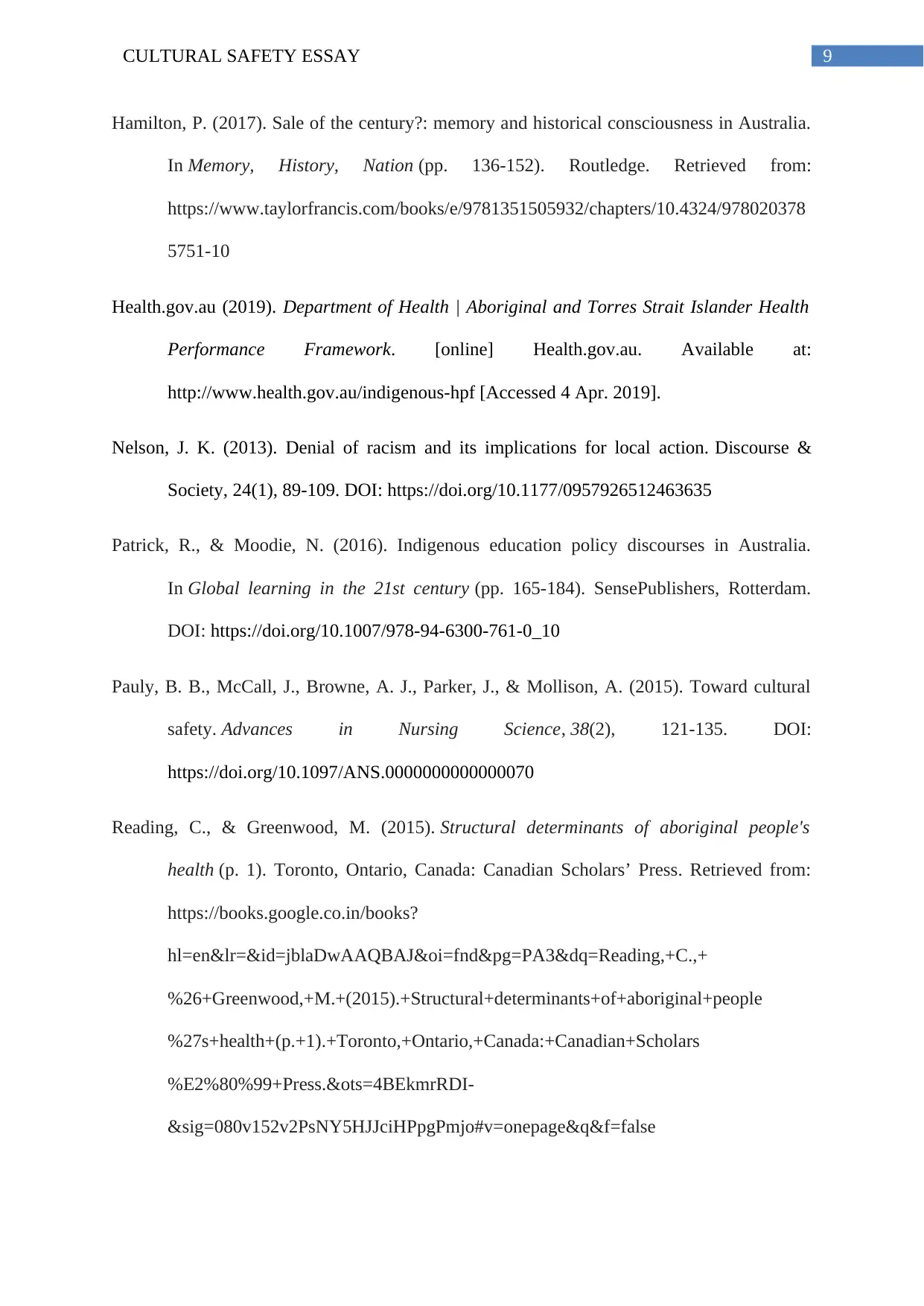
9CULTURAL SAFETY ESSAY
Hamilton, P. (2017). Sale of the century?: memory and historical consciousness in Australia.
In Memory, History, Nation (pp. 136-152). Routledge. Retrieved from:
https://www.taylorfrancis.com/books/e/9781351505932/chapters/10.4324/978020378
5751-10
Health.gov.au (2019). Department of Health | Aboriginal and Torres Strait Islander Health
Performance Framework. [online] Health.gov.au. Available at:
http://www.health.gov.au/indigenous-hpf [Accessed 4 Apr. 2019].
Nelson, J. K. (2013). Denial of racism and its implications for local action. Discourse &
Society, 24(1), 89-109. DOI: https://doi.org/10.1177/0957926512463635
Patrick, R., & Moodie, N. (2016). Indigenous education policy discourses in Australia.
In Global learning in the 21st century (pp. 165-184). SensePublishers, Rotterdam.
DOI: https://doi.org/10.1007/978-94-6300-761-0_10
Pauly, B. B., McCall, J., Browne, A. J., Parker, J., & Mollison, A. (2015). Toward cultural
safety. Advances in Nursing Science, 38(2), 121-135. DOI:
https://doi.org/10.1097/ANS.0000000000000070
Reading, C., & Greenwood, M. (2015). Structural determinants of aboriginal people's
health (p. 1). Toronto, Ontario, Canada: Canadian Scholars’ Press. Retrieved from:
https://books.google.co.in/books?
hl=en&lr=&id=jblaDwAAQBAJ&oi=fnd&pg=PA3&dq=Reading,+C.,+
%26+Greenwood,+M.+(2015).+Structural+determinants+of+aboriginal+people
%27s+health+(p.+1).+Toronto,+Ontario,+Canada:+Canadian+Scholars
%E2%80%99+Press.&ots=4BEkmrRDI-
&sig=080v152v2PsNY5HJJciHPpgPmjo#v=onepage&q&f=false
Hamilton, P. (2017). Sale of the century?: memory and historical consciousness in Australia.
In Memory, History, Nation (pp. 136-152). Routledge. Retrieved from:
https://www.taylorfrancis.com/books/e/9781351505932/chapters/10.4324/978020378
5751-10
Health.gov.au (2019). Department of Health | Aboriginal and Torres Strait Islander Health
Performance Framework. [online] Health.gov.au. Available at:
http://www.health.gov.au/indigenous-hpf [Accessed 4 Apr. 2019].
Nelson, J. K. (2013). Denial of racism and its implications for local action. Discourse &
Society, 24(1), 89-109. DOI: https://doi.org/10.1177/0957926512463635
Patrick, R., & Moodie, N. (2016). Indigenous education policy discourses in Australia.
In Global learning in the 21st century (pp. 165-184). SensePublishers, Rotterdam.
DOI: https://doi.org/10.1007/978-94-6300-761-0_10
Pauly, B. B., McCall, J., Browne, A. J., Parker, J., & Mollison, A. (2015). Toward cultural
safety. Advances in Nursing Science, 38(2), 121-135. DOI:
https://doi.org/10.1097/ANS.0000000000000070
Reading, C., & Greenwood, M. (2015). Structural determinants of aboriginal people's
health (p. 1). Toronto, Ontario, Canada: Canadian Scholars’ Press. Retrieved from:
https://books.google.co.in/books?
hl=en&lr=&id=jblaDwAAQBAJ&oi=fnd&pg=PA3&dq=Reading,+C.,+
%26+Greenwood,+M.+(2015).+Structural+determinants+of+aboriginal+people
%27s+health+(p.+1).+Toronto,+Ontario,+Canada:+Canadian+Scholars
%E2%80%99+Press.&ots=4BEkmrRDI-
&sig=080v152v2PsNY5HJJciHPpgPmjo#v=onepage&q&f=false
Secure Best Marks with AI Grader
Need help grading? Try our AI Grader for instant feedback on your assignments.
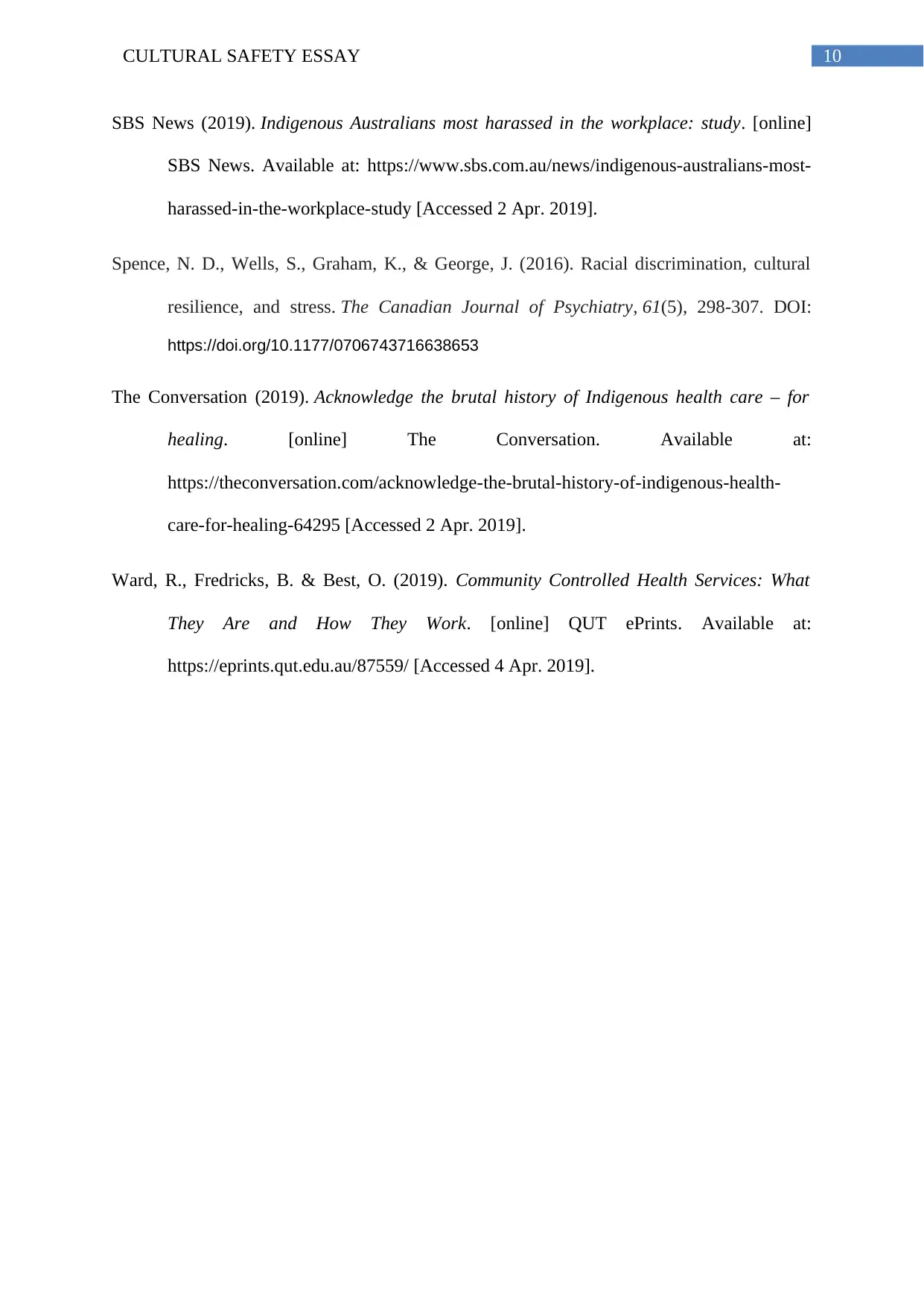
10CULTURAL SAFETY ESSAY
SBS News (2019). Indigenous Australians most harassed in the workplace: study. [online]
SBS News. Available at: https://www.sbs.com.au/news/indigenous-australians-most-
harassed-in-the-workplace-study [Accessed 2 Apr. 2019].
Spence, N. D., Wells, S., Graham, K., & George, J. (2016). Racial discrimination, cultural
resilience, and stress. The Canadian Journal of Psychiatry, 61(5), 298-307. DOI:
https://doi.org/10.1177/0706743716638653
The Conversation (2019). Acknowledge the brutal history of Indigenous health care – for
healing. [online] The Conversation. Available at:
https://theconversation.com/acknowledge-the-brutal-history-of-indigenous-health-
care-for-healing-64295 [Accessed 2 Apr. 2019].
Ward, R., Fredricks, B. & Best, O. (2019). Community Controlled Health Services: What
They Are and How They Work. [online] QUT ePrints. Available at:
https://eprints.qut.edu.au/87559/ [Accessed 4 Apr. 2019].
SBS News (2019). Indigenous Australians most harassed in the workplace: study. [online]
SBS News. Available at: https://www.sbs.com.au/news/indigenous-australians-most-
harassed-in-the-workplace-study [Accessed 2 Apr. 2019].
Spence, N. D., Wells, S., Graham, K., & George, J. (2016). Racial discrimination, cultural
resilience, and stress. The Canadian Journal of Psychiatry, 61(5), 298-307. DOI:
https://doi.org/10.1177/0706743716638653
The Conversation (2019). Acknowledge the brutal history of Indigenous health care – for
healing. [online] The Conversation. Available at:
https://theconversation.com/acknowledge-the-brutal-history-of-indigenous-health-
care-for-healing-64295 [Accessed 2 Apr. 2019].
Ward, R., Fredricks, B. & Best, O. (2019). Community Controlled Health Services: What
They Are and How They Work. [online] QUT ePrints. Available at:
https://eprints.qut.edu.au/87559/ [Accessed 4 Apr. 2019].
1 out of 11
Related Documents
Your All-in-One AI-Powered Toolkit for Academic Success.
+13062052269
info@desklib.com
Available 24*7 on WhatsApp / Email
![[object Object]](/_next/static/media/star-bottom.7253800d.svg)
Unlock your academic potential
© 2024 | Zucol Services PVT LTD | All rights reserved.





